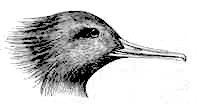Bird Beaks
Did you ever wonder why there are so many types of bird beaks or bills? The most important function of a bird bill is feeding, and it is shaped according to what a bird eats. The bill is one of the characteristics used to identify birds. You can learn about bird behavior by looking at the bill and thinking about what it eats. Then you may think about where it lives, and so on. Below are some common bill shapes and a description of the food they are especially adapted to eat.
After reviewing this material try the Beaks to Eats Activity
 |
A cone shaped bill is found in many birds such as finches and grosbeaks. It is a strong beak used for cracking seeds. |
|
Thin, slender, pointed beaks are found mainly in insect eaters. They are used to pick insects off leaves, twigs, and bark. This warbler is a good example. |
 |
Woodpeckers have strong beaks which taper to the tip, forming a chisel for pecking holes in trees for food or nests. Most feed on insects which live under the bark. |
 |
Hummingbirds have long, tubular bills that resemble straws, which they use to sip nectar from flowers. |
 |
Mergansers, specialized for eating fish, have sharp tooth-like structures on the edge of the bill to hold fish tightly. |
 |
Hawks, owls, and other birds of prey which catch and kill live prey have sharp, "hooked" beaks. These are used to bite the skull or neck and also to tear the body into pieces small enough to swallow. |
 |
The edges of a Mallard's bill are fringed to strain plants, seeds, and small animals from mud and water. |
|
Beaks which are flat and wide at the base are found in birds which catch insects in flight, such as flycatchers. These birds also often have "whiskers," which are actually modified feathers, at the corners of the mouth, which effectively widens the mouth opening, allowing more effective capture of prey. |

